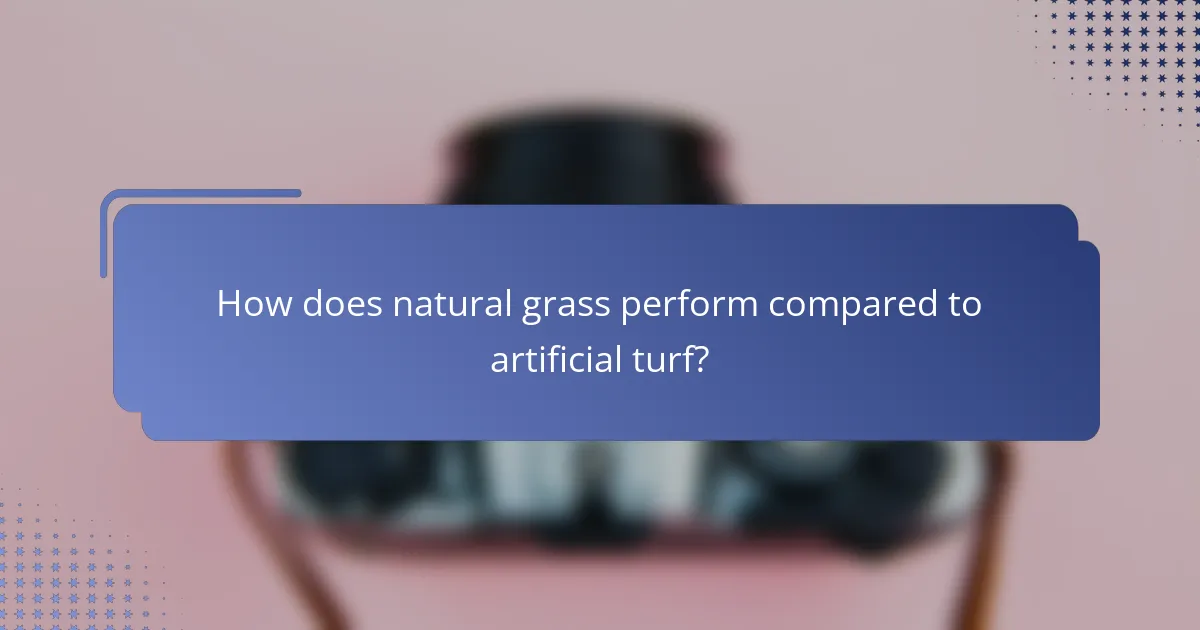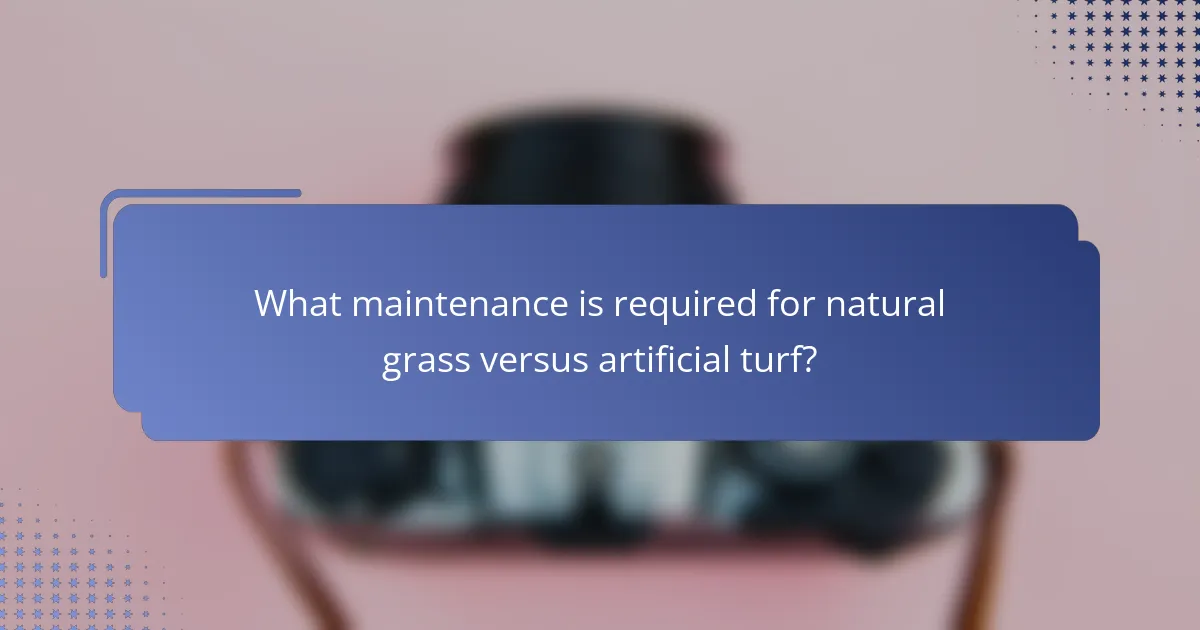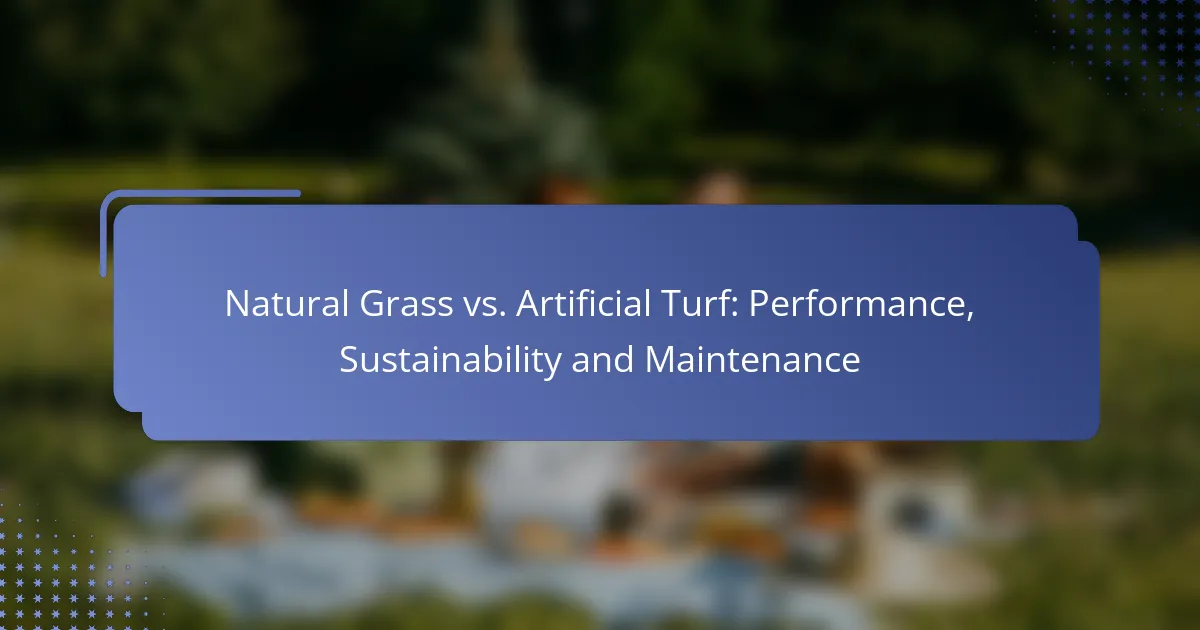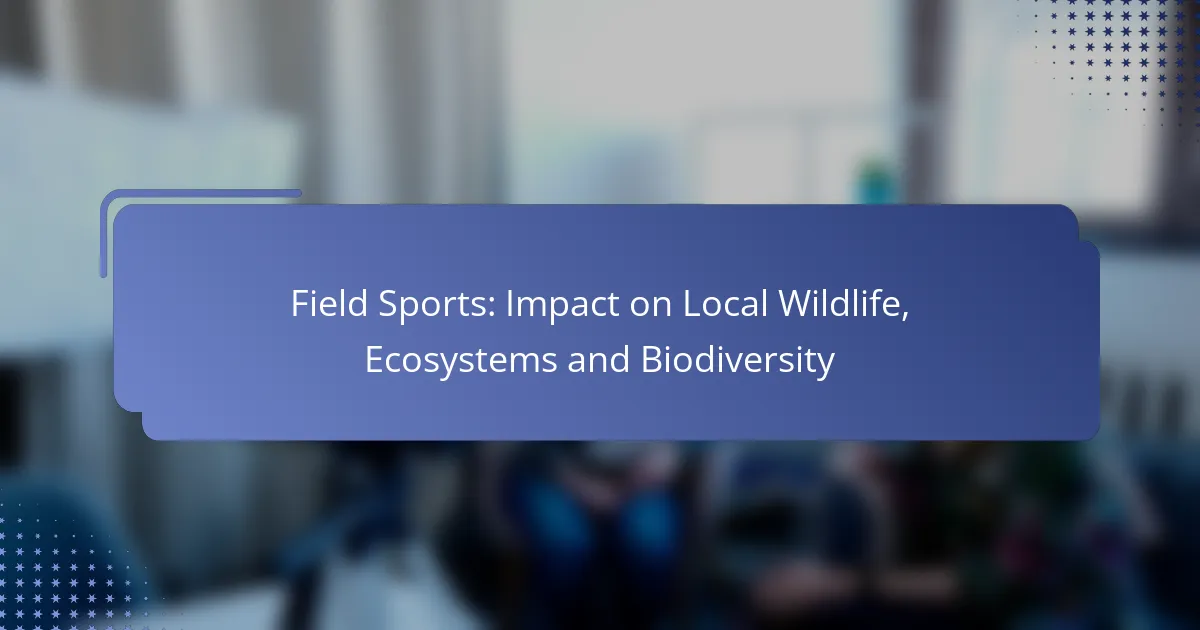The debate between natural grass and artificial turf encompasses performance, sustainability, and maintenance considerations. Natural grass is often praised for its superior traction and player comfort, while artificial turf offers consistent playing conditions with lower maintenance demands. Evaluating the environmental impacts and upkeep requirements of each option is essential for making informed choices in landscaping and sports facilities.

How does natural grass perform compared to artificial turf?
Natural grass typically offers superior performance in terms of traction and player comfort, while artificial turf provides consistent playing conditions. Each option has distinct advantages and trade-offs that can influence the choice for sports fields or recreational areas.
Natural grass provides better traction
Natural grass surfaces generally deliver better traction, especially in wet conditions. The organic fibers of grass allow for more grip, reducing the likelihood of slips and falls during play. This can be particularly important for sports that require quick directional changes, such as soccer or football.
Players often report feeling more secure on grass, which can enhance performance and confidence. However, maintaining optimal traction on natural grass requires regular upkeep, including mowing and watering, to keep the surface healthy and resilient.
Artificial turf offers consistent playing conditions
Artificial turf is designed to provide uniform playing conditions regardless of weather. Unlike natural grass, which can become muddy or uneven, synthetic surfaces maintain a consistent texture and firmness. This reliability can be crucial for training and competitive play.
Moreover, artificial turf can be used year-round without the downtime associated with natural grass recovery. This makes it a popular choice for facilities that host frequent events or activities, ensuring that the field is always ready for use.
Natural grass has a softer feel
The softness of natural grass contributes to a more comfortable playing experience. Players often prefer the cushioning effect of grass, which can reduce fatigue and impact on joints during play. This is particularly beneficial for sports that involve a lot of running or jumping.
Additionally, the natural texture of grass can enhance the overall aesthetic appeal of a field, making it more inviting for players and spectators alike. However, this softness can diminish if the grass is not properly maintained, leading to hard patches that may affect performance.
Artificial turf reduces injury risk
Artificial turf is engineered to minimize certain types of injuries, particularly those related to surface irregularities. The consistent surface can help prevent ankle sprains and other common injuries associated with uneven ground. This is a significant factor for many organizations when selecting a playing surface.
However, some studies suggest that the risk of specific injuries, such as ACL tears, may be higher on artificial turf due to its rigidity. Therefore, while artificial turf can reduce some injury risks, it is essential to consider the type of sport and the playing conditions when making a decision.

What are the sustainability aspects of natural grass and artificial turf?
The sustainability of natural grass and artificial turf involves various factors including their impact on biodiversity, water usage, carbon absorption, and the environmental costs of production. Understanding these aspects helps in making informed choices for landscaping and sports facilities.
Natural grass supports biodiversity
Natural grass ecosystems provide habitats for numerous species, including insects, birds, and small mammals. This biodiversity contributes to a balanced environment, promoting pollination and pest control.
In contrast, artificial turf typically lacks the ability to support wildlife, leading to a reduction in local biodiversity. Choosing natural grass can enhance ecological health in urban and suburban areas.
Artificial turf reduces water usage
Artificial turf requires minimal water compared to natural grass, which needs regular irrigation to thrive. This can lead to significant water savings, especially in arid regions where water scarcity is a concern.
However, while artificial turf conserves water, it does not contribute to groundwater replenishment or provide the cooling effects associated with natural grass, which can be important in urban heat mitigation.
Natural grass absorbs CO2
Natural grass plays a crucial role in carbon sequestration, absorbing carbon dioxide from the atmosphere and helping to mitigate climate change. Healthy grasslands can capture and store carbon effectively over time.
This natural process not only benefits the environment but also enhances air quality, making natural grass a valuable asset in urban planning and landscaping.
Artificial turf involves plastic production
The production of artificial turf involves significant use of plastics, which raises concerns about environmental sustainability. The manufacturing process contributes to greenhouse gas emissions and relies on non-renewable resources.
Additionally, the disposal of artificial turf at the end of its life cycle poses challenges, as it is not biodegradable and can contribute to landfill waste. Opting for natural grass can reduce reliance on synthetic materials and their associated environmental impacts.

What maintenance is required for natural grass versus artificial turf?
Natural grass requires consistent upkeep, including mowing and fertilization, while artificial turf demands less frequent maintenance, primarily cleaning. Understanding these differences helps in making informed decisions based on time, cost, and environmental impact.
Natural grass needs regular mowing
Maintaining natural grass involves regular mowing to keep the lawn at an optimal height, typically between 2 to 4 inches. This process usually occurs weekly during the growing season, which can vary based on climate and grass type.
Neglecting to mow can lead to overgrowth, which may attract pests and diseases. Homeowners should invest in a reliable mower and consider the time commitment required for this task.
Artificial turf requires occasional cleaning
Artificial turf maintenance is simpler, requiring occasional cleaning to remove debris and prevent odors. A quick rinse with water and a broom can suffice, typically done every few weeks or after heavy use.
For deeper cleaning, using a mild detergent and a hose can help maintain the turf’s appearance and hygiene. This low-maintenance approach is one of the key advantages of artificial grass.
Natural grass requires fertilization
Natural grass benefits from regular fertilization to promote healthy growth and color. This process usually occurs 2 to 4 times a year, depending on the grass type and soil conditions.
Choosing the right fertilizer, whether organic or synthetic, is crucial. Homeowners should test their soil to determine nutrient needs and avoid over-fertilization, which can harm the environment.
Artificial turf has lower long-term maintenance
In the long run, artificial turf generally requires less maintenance than natural grass. Once installed, it does not need watering, mowing, or fertilization, significantly reducing ongoing costs and labor.
While the initial investment in artificial turf can be higher, the reduced maintenance can lead to savings over time, making it an appealing option for busy homeowners or those in drought-prone areas.

What are the costs associated with natural grass and artificial turf?
The costs of natural grass and artificial turf vary significantly, affecting initial investment and long-term maintenance. Natural grass typically incurs higher installation costs, while artificial turf can offer lower expenses over time.
Natural grass has higher installation costs
Installing natural grass often requires substantial upfront investment, including soil preparation, seed or sod purchase, and irrigation systems. Depending on the region, initial costs can range from several hundred to a few thousand USD per 1,000 square feet.
Additionally, ongoing expenses for fertilizers, pesticides, and water can add to the overall financial commitment. Regular maintenance, such as mowing and aeration, further contributes to the total cost of ownership.
Artificial turf has lower long-term costs
While the initial installation of artificial turf can be higher, typically ranging from a few thousand to over ten thousand USD per 1,000 square feet, it tends to offer lower long-term costs. Once installed, artificial turf requires minimal maintenance, eliminating expenses for mowing, watering, and fertilization.
Over time, the savings on water bills and maintenance can offset the initial investment, making artificial turf a cost-effective option for many property owners. However, it’s essential to consider the lifespan of the turf, which can last 10-15 years with proper care, before making a decision.

How do climate conditions affect the choice between natural grass and artificial turf?
Climate conditions significantly influence the decision between natural grass and artificial turf. Factors such as temperature, rainfall, and humidity can determine the viability, maintenance needs, and performance of each option.
Natural grass thrives in temperate climates
Natural grass is best suited for temperate climates where temperatures range from mild to warm, and rainfall is consistent. In these regions, grass can grow robustly, benefiting from seasonal changes that promote healthy root systems.
In areas with moderate rainfall, natural grass requires less irrigation, making it a sustainable choice. However, in extreme heat or drought conditions, grass may struggle, necessitating additional watering and care.
For optimal results, consider local grass varieties that are adapted to your specific climate. Choosing the right species can enhance resilience and reduce maintenance costs.
Artificial turf performs well in diverse climates
Artificial turf is designed to withstand a variety of climate conditions, making it a versatile option for regions with extreme weather. It remains functional in both hot and cold temperatures, providing consistent performance regardless of environmental challenges.
In areas prone to drought or heavy rainfall, artificial turf eliminates the need for irrigation and minimizes mud issues. This can lead to lower water bills and reduced maintenance efforts, making it an appealing choice for many homeowners and sports facilities.
However, be mindful of heat retention in hot climates, as artificial surfaces can become significantly warmer than natural grass. Selecting turf with heat-reflective properties can mitigate this issue.



